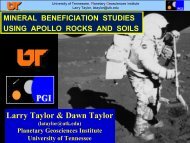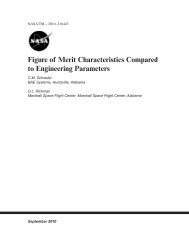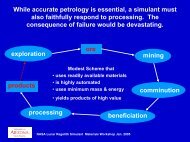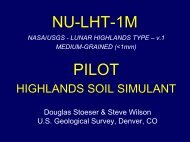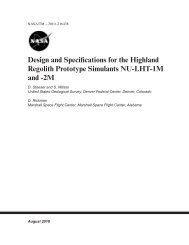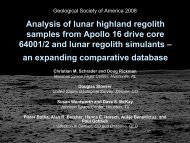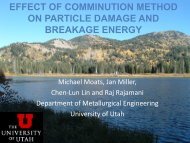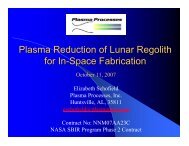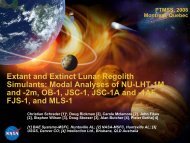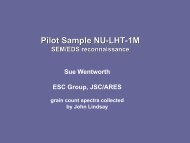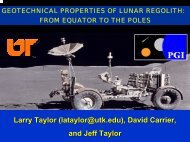Book of Abstracts- Lunar Regolith Simulant Materials Workshop
Book of Abstracts- Lunar Regolith Simulant Materials Workshop
Book of Abstracts- Lunar Regolith Simulant Materials Workshop
You also want an ePaper? Increase the reach of your titles
YUMPU automatically turns print PDFs into web optimized ePapers that Google loves.
grained material which is in turn a function <strong>of</strong> the regolith<br />
thickness (Fig 8).<br />
In regions <strong>of</strong> thin regolith, the supply <strong>of</strong> coarsegrained<br />
material will be greater and the steady-state<br />
grain size floor will be higher. No soil in that region is<br />
likely to be finer than a certain limiting value. Conversely,<br />
in regions <strong>of</strong> thick regolith, bedrock is reaching<br />
much less frequency by impacts so the supply <strong>of</strong><br />
fresh coarse ejecta is lower and the mean grain size<br />
may reach lower values. If no new coarse material<br />
were added, a result <strong>of</strong> an infinitely thick regolith, the<br />
equilibrium mean the balance between communition<br />
and agglutination would establish the mean grain size.<br />
This suggests a relationship between regolith thickness<br />
and mean grain size. Figure 9 shows the regolith<br />
thickness estimated by various techniques plotted<br />
against the mean grain size and the maximum and<br />
minimum grain size at each Apollo site.<br />
The correlation shown in Figure 10 can be used to<br />
predict the finest grain size from estimation <strong>of</strong> regolith<br />
thickness, something that can be done from orbit. It<br />
can also be used to estimate the regolith thickness if a<br />
number <strong>of</strong> grain size analyses is available for a site.<br />
In summary, the evolution <strong>of</strong> the lunar regolith has<br />
been complex and has resulted from a dynamic system<br />
producing several systematic correlations and relationships.<br />
Understanding those relationships may allow us<br />
to produce more appropriate simulants and allow us to<br />
understand how our simulants may differ from actual<br />
lunar regolith.<br />
References: All figures are from D. S. McKay et<br />
al., 1974, Grain size and the evolution <strong>of</strong> lunar soils,<br />
Proceedings <strong>of</strong> the Fifth <strong>Lunar</strong> Conference, Supplement<br />
5, Geochemica et Cosmochemica Acta, Vol. 1,<br />
pp 887-906.<br />
No correlation is obvious between mean grain size<br />
and regolith thickness. However if only the finestgrained<br />
soil sample at each site is used, a strong correlation<br />
is seen with regolith thickness. This finest grain<br />
size may represent the steady state baseline at each site<br />
as shown in Figure 8.<br />
7



